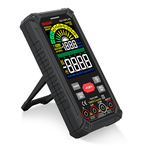What is the possible reason for the mechanical multimeter resistance range to be broken?
If the resistance range of a mechanical multimeter, i.e. a pointer multimeter, is damaged while other ranges can be tested normally, it indicates that the meter head should not be affected. According to the testing principle of the multimeter's resistance range, it is highly likely that the precision resistor for shunt and voltage division in the resistance range has burned out or the resistance value has changed. The most likely cause of damage to the resistance range of a mechanical multimeter is to test the voltage by using the resistance range as the voltage range. So, before each test, it is important to get used to checking if the gear is selected correctly and develop good testing habits.
The resistance gear of the pointer multimeter is broken, but other gears can be used, indicating that the meter head is good. This is caused by incorrect use. There are two reasons for this. One is to measure several small resistance wire wound resistors in the AC220V voltage burning current mode when unplugged from the DC current mode (regardless of the type of pointer multimeter, they are all wire wound resistors made of constantan resistance wire, and the resistance values are very small. For example, in the MF-47 type, there are four resistors with 0.54 Ω, 5.4 Ω, 54 Ω, and 540 Ω, respectively). But if the multimeter mentioned only has a problem with the resistance gear, then there is no need for the problem to occur in this gear.
The second reason is that; For novice electronics and electricians, if they fail to set the multimeter to AC 500V and then test AC power in a 220V AC line or socket after using the multimeter's resistance range to measure components or check circuits. There are many models and manufacturers of commonly used pointer multimeters. The most common and widely used are the old-fashioned 500 model and the MF-47 multimeter produced in Nanjing.
① The MF-47 multimeter has a direct current mode (DCA), with a total of five commonly used modes and an additional 5A high current expansion socket, ranging from 0~0.05mA~0.5mA~5mA-50mA-500mA.
② It has eight commonly used gears for direct current voltage (DCV) and an expansion socket that can measure DC2500V. 0~0.25V~1V~2.5V~10V~50V~500V~1000V~2500V.
③ There are six levels of alternating current voltage (ACV), ranging from 0~10V~50V~250V~500V~2500.
④ It has five DC resistance levels (Ω). R × 1 Ω R × 10 Ω R × 100 Ω Rx 1K Ω R × 10K Ω There is also a road buzzer for measurement (when the resistance value of the line is between 3-10 Ω, the buzzer will emit a prompt sound). Due to space limitations, functions such as transistor DC amplification factor hFE, infrared remote control transmission signal detection, and audio level DB are omitted.
Firstly, when measuring the resistance range, the black probe is inserted into a hole → the negative terminal of the meter → the 20.2 Ω resistor, 220.4 Ω resistor, and 2430 Ω resistor, all of which are in parallel with the meter. At this time, the red probe is inserted into the ten socket of the multimeter, passes through a 1A fuse tube, a 1.5V dry battery, and a resistor in series, then passes through a 20k resistor, a 1.7k resistor, a variable potentiometer for zero adjustment, a 500 Ω resistor, another meter head calibration R+, and the positive pole+sign of the meter head. Once you understand the closed loop, it's easy to handle. Based on personal experience, you can search for it by following the clues.






